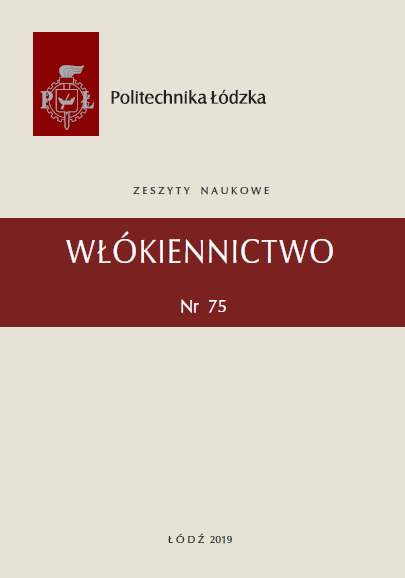Abstract
The following dissertation is based on the author's over ten years of professional experience. The author's area of interests and activities coincide with the scientific area of the work environment.
The nature of the dissertation qualifies it for the application category. The result of technological work is an innovative construction of curtain fabric with barrier properties for visible light (VIS). There is a demand for the expected research result in a well-defined area of interior furnishing of public utilities in the hotel sector and business zone (HoReCa and MICE). The work includes pioneering research on the possibility of multiplication of functions in multilayer fabrics, with their simultaneous separation and assignment to each of layers. On the other hand, a huge scientific contribution of the work is a new objective method of assessing the new generation of blackout fabrics with barrier properties resulting from the special fabric structure.
The subject of this publication is the methodology for assessing the barrier properties of blackout fabrics developed for the purpose of assessing the new construction of curtain fabric and its subsequent classification.
The authorial methodology for assessing the barrier phenomenon of curtain fabrics was developed using a designed test stand for linear tracking of the fabric structure.
The study confirmed that due to this method, the desired measurement sensitivity was achieved, which detects individual lumens and each change in the structural structure of fabrics. It has been shown that the determined barrier indicators Transmittance (Pn) and Blackout Capability (Ztk, n) calculated on the basis of the sums of intensity values describe the variability of the structure on the defined surface of the fabric in a quantitative and therefore objective way.
Both the test stand and the developed methodology of evaluating the darkening capabilities of blackout fabrics have been adapted for further implementation in industrial applications.
References
PN-EN 14501:2005, Zasłony i żaluzje – Komfort cieplny i wizualny – Właściwości eksploatacyjne i klasyfikacja.
PN-EN 12216:2004, Żaluzje, zasłony zewnętrzne, zasłony wewnętrzne – Terminologia, słownik i definicje.
Lesińska L.: Hotel ubrany w tkaninę, Hotelarz 2011, nr 7, http://www.e-hotelarz.pl/htdocs/e-hotelarz.pl/ mht/?s=Hotel+ubrany+w+ tkanin%C4%99, dostęp: 20.08.2019.
Cieślak T., Zawadzki A.: Postęp w technologii powlekania wyrobów włókienniczych, XXV Seminarium Polskich Kolorystów, technologie wykończalnicze bezpieczne dla środowiska i zdrowia człowieka, 2009, ISBN 978-83-927176-1-4, ss. 88-101, http://www.kolorysci.org.pl/download/mat-sem/kolorysci_2009.pdf, dostęp: 20.08.2019.
https://en.wikipedia.org/wiki/Rockland_Industries, dostęp: 20.08.2019.
http://www.roc-lon.com/company/add_performance.html#q1, dostęp: 20.08.2019.
Szosland J.: Struktury tkaninowe, ISBN 83-86492-42-2, Polska Akademia Nauk, Oddział w Łodzi, Łódź 2007.
Nycz E. i in.: Budowa tkanin, ISBN 83-02-03229-8, WSIP, Warszawa 1999.
Materiały informacyjne firmy Hallmark Blinds, http://www.hallmarkblinds.co.uk/saveenergy, dostęp: 20.08.2019.
PN EN 13120:2005.
http://www.wygasz.edu.pl/index.php/jak-zmierzyc-swiatlo.html, dostęp: 20.08.2019.
http://pollighting.pl/optical-safety-polv31052011, dostęp: 20.08.2019.
PN-EN 14500:2008, Żaluzje i zasłony – komfort cieplny i wizualny – Metody badań i obliczeń.
AS/NZS 4399:1996, Sun protective clothing — Evaluation and classification.
AS/NZS 2604:1986, Sunscreen products — Evaluation and classification.
PN-EN 13758-1:2007, Tekstylia – Właściwości ochronne przed działaniem promieniowania UV – Część 1: Metoda badania płaskich wyrobów włókienniczych.
Procedura badawcza PR/17/2007, Płaskie wyroby włókiennicze. Badanie Transmisji światła w zakresie od 400 nm do 700 nm, zgodna z normą PN-EN 13758-1:2007, Laboratorium badań chemicznych i analiz instrumentalnych, Instytut Włókiennictwa, 2008.
AATCC TM 148-2015, Light Blocking Effect of Textiles and Related Materials: Photodetector Method.
AATCC TM 203-2014, Light Blocking Effect of Textiles: Spectrophotometric Method.
AATCC TM 183:2004, Transmittance or Blocking of Erythemally Weighted Ultraviolet Radiation through Fabrics.
AS 4174:1994, Synthetic shade cloth. Requirements for shade cloth.
Javorniczky J.: Review of the Synthetic Shadecloth Standard AS 4174:1994, 3rd International Conference on UV & Skin Cancer Prevention, Melbourne Australia 7-11 December 2015, http://uvandskincancer2015.org/cms/wp-content/uploads/2016/02/Javorniczky_John_Review-of-the-synthetic-shadecloth.pdf, dostęp: 20.08.2019.
Bilimis Zafira: Measuring the cover and shade protection factors of synthetic shadecloth, Application Note, Publication Number SI-A-1149, 2011, https://www.agilent.com/cs/library/applications/uv68.pdf, dostęp: 20.08.2019.
Tapias Montserrat, Ralló Miquel, Jaume Escofet Soteras, Inés María Algaba Joaquín, Ascensión Riva Juan: Objective Measure of Woven Fabric’s Cover Factor by Image Processing, Textile Research Journal 2010, nr 80(1), DOI: 10.1177/0040517509104471.
Parmar M.S., Singh Maheshwar: Development an Instrument to Determine Light and Heat Cutting Ability of Textiles, ISSN 0010-1826, Colourage 2013, Vol. 60, Issue 7, ss. 39-41.
Parmar M.S.: Indian Pat, Patent Aplication No 180/Del/2012, 20.01.2012.
Parmar M.S.: Sisodia Nidhi, Singh Maheshwar, An apparatus for quantification of Light and temperature cutting ability of curtains, Indian Journal of Fibre & Textile Research 2015, Vol. 40, ss. 231-235.
Lewartowska J., Bąk P., Marzec S.: Propozycja kryteriów oceny właściwości użytkowych wyrobów włókienniczych chroniących przed nadfioletem, Prace Instytutu Elektrotechniki 2008, z. 237, lewartowska13.pdf, dostęp: 20.08.2019.
Hemka L., Piotrowski L., Lewartowska J., Lota W.: Opracowanie metodyki badań oraz kryteriów oceny właściwości barierowych dla UV materiałów wyposażenia wnętrz i do budownictwa, Prace Instytutu Elektrotechniki 2010, z. 245, ss. 301-315.
Stempień Z., Dominiak J., Sulerzycka-Bil M.: Protection Properties of Wowen Fabrics. Against High-intensity UV Radiation Emitted by Artificial Sources, Fibres&Textiles In Ekstern Europe 2013,nr 21, 2 (98), ss. 96-102.
Szmyt J., Mikołajczyk Z.: Experimental Identification of Light Barier Properties Of Decorative Jacquard Knitted Fabrics, Fibres & Textiles In Eastern Europe 2013, nr 21, 2(98), ss. 104-110.
Ahsan Nazir, Tanveer Hussain, Ali Afzal, Sajid Faheem, Waseem Ibrahim, Muhammad Bilal: Prediction and Corelation of Air Permeability and Light Transmission Properties of Woven Cotton Fabrics, Autex Research Journal, https://scholar.google.com/scholar_lookup?title=Prediction+and+correlation+of+air+permeability+and+light+transmission+properties+of+woven+cotton+fabrics&author=A.+Nazir&author=T.+Hussain&author=A.+Afzal&author=S.+Faheem&author=W.+Ibrahim&author=M.+Bilal&publication_year=2016, dostęp: 20.06.2017.
Manoj Kumar Imrith, Roshan Unmar, Satyadev Rosunee: Investigating the Relationship between Knitted Fabric Porosity and Light Permeability, Indian Journal of Materiale Science 2016, http://dx.doi.org/10.1155/2016/7536108, dostęp: 20.08.2019.
Informacje normalizacyjne PKN, https://www.pkn.pl/polskie-normy/wykazy-pn, Dostęp: 04.10.2017.
Katalog oświetlenia LED marki ART., http://www.art-multimedia.pl, http://pliki.mo.pl/files/public/exchange/EXCHANGE/ART-multimedia%20-%20Katalogi/2015-10-15%20Katalog%20LED.pdf, dostęp: 20.08.2019.
Materiały informacyjne firmy Ocean Optics, https://oceanoptics.com/product-category/hr-series/https://oceanoptics.com//wp-content/uploads/hr4000cg-uv-nir-150x150.jpg, 2007_catalog.pdf, dostęp: 20.08.2019.

